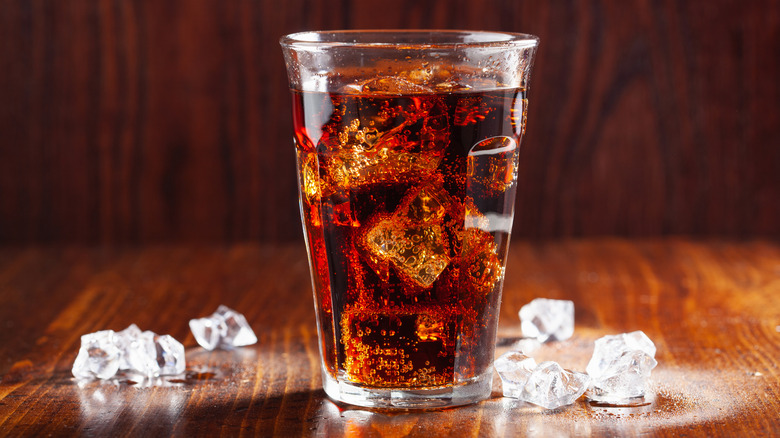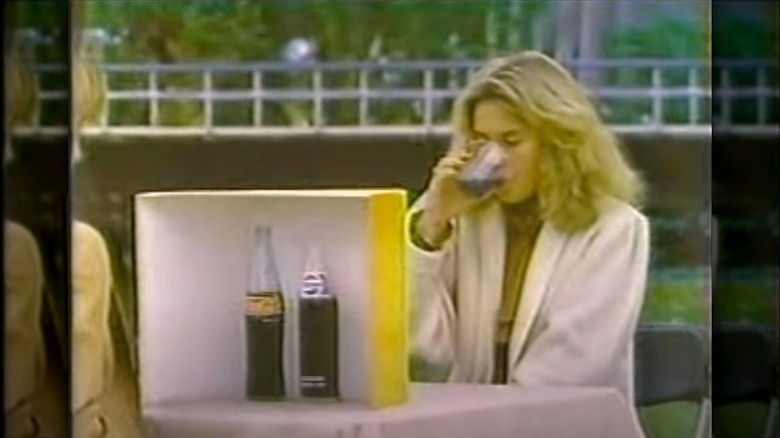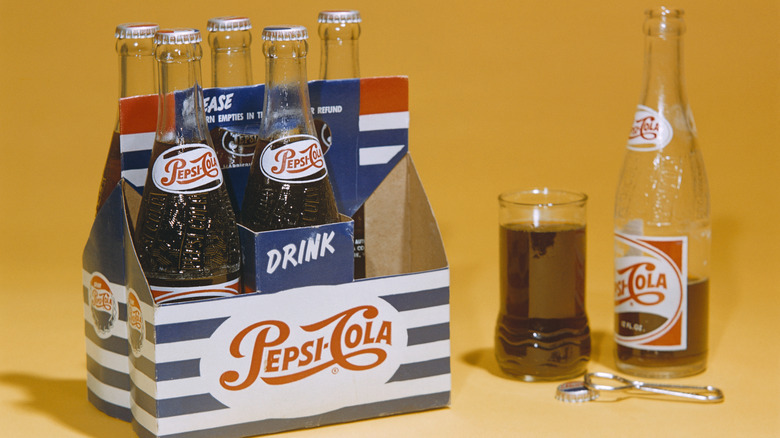Yes, Coca-Cola And Pepsi Actually Do Taste Different
You know where your loyalty lies when it comes to Coca-Cola and Pepsi. But does that preference have anything to do with the taste itself? Since the 80s, the Cola Wars have caused a great divide in our choice of drink, creating a fizzling feud with no end in sight. Commercials, endorsements, sponsorships — Coca-Cola even created the modern characterization of Santa Claus. Still, we can't help but wonder if there's some truth behind PepsiCo's blind taste test campaigns. Does it have something that makes it taste different than Coke? Turns out, it does.
Unlike Coca-Cola, Pepsi has a stronger tang hidden behind the bubbles of its soft drinks. They're sharp and zesty with a mouth-smacking bite at the end. This is due to the inclusion of citric acid, incorporated to mask the overly sweet taste and sugariness of corn syrup — which Pepsi has a lot of. Coca-Cola is most often referred to when discussing our recommended daily intake of sugar (it contains 39 grams in a 12-ounce bottle). However, a 12-ounce can of Pepsi ranks above it with a staggering 41 grams. This is where the citric acid comes in. Citric acid is relatively more tart and a great counterpart in beverages that are a tad too sweet for imbibers. The dissimilarities don't end there. While Pepsi has more sugar, Coca-Cola sees Pepsi's sodium intake and raises it by double. Why does this matter? Sodium (which we derive the word "soda" from) has many functions. It reduces acidity, makes the drink taste better, and most importantly, it makes us thirstier.
PepsiCo's marketed taste test campaign
One of PepsiCo's most popular advertisements — besides the infamous Harrier Jet contest — is the Pepsi Challenge blind taste test. Their commercials depicted randomly selected strangers sipping on unmarked colas to determine which brand they ultimately enjoy best. One after the other, the choice is Pepsi. An 80's montage plays out the rest of the commercial, focusing on how fun a crisp bottle of cold Pepsi truly is in the sun. People often say that there's an obvious difference between the two. Coke has a more vanilla profile, whereas Pepsi has an upfront zing that zaps the tongue. Yet, the two can only be accurately distinguished a little over half the time.
Once again, Pepsi's sugar content is at play. Author Malcolm Gladwell (via Business Insider) explains that those who can distinguish the two often prefer Pepsi because it is more sugary than Coke. The logic goes as follows: The sweeter something is, the more likely we are to favor it. And when paired with citric acid, it will produce a more intense sipping sensation. But as Gladwell states, "that burst tends to dissipate over the course of an entire can, and that is another reason Coke suffered by comparison. Pepsi, in short, is a drink built to shine in a sip test." Despite Pepsi's title as the taste test titan, Coca-Cola was the first to step into the ring. So, for most drink devotees, this automatically makes Coke the champion of the Cola Wars.
Your cola's container may effect the outcome of its taste
Long live the long-necked glass bottle! Stylish, effective, and economically friendly, the glass bottle provided us with an excess of services from the early 1800s to the mid-1970s. The bottle was part of all things vintage Coke and Pepsi, including some of our favorite timeless advertisements. But the classic glass bottle wasn't just used for its appearance — it actually made your cola taste better. Compared to plastic or aluminum cans, glass is formidable against exterior factors. Carbonation is unable to leak through the material, nor can intense heat infuse toxic chemicals into the soda. Basically, glass keeps everything that's supposed to be in, in, and everything that's supposed to be out, out. Plus, it doesn't have any misleading side-tastes, such as metal from aluminum cans or chemicals from plastic bottles.
Aluminum cans were introduced to Coke in the 1960s for consumer portability. Still, their product was advertised in glass bottles to reassure consumers that the recipe did not alter or change. The aluminum cans were a hit and propelled Coca-Cola's sales. The only problem was that it didn't exactly taste the same. Both aluminum cans and plastic bottles are made from a variety of components, such as polyethylene terephthalate. When soda is added to the mixture, it is possible for some of these chemicals to alter the taste of the carbonated beverage inside. Thus leading to a less-than-satisfactory experience for both the consumer and the Earth.


